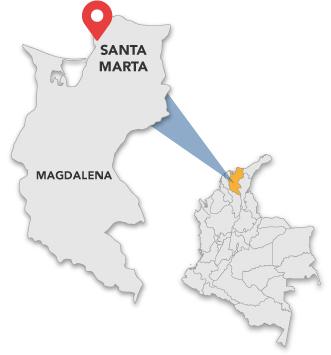
4 minute read
3.2. SANTA MARTA: SOCIO-ECONOMIC CONTEXT
3.2. SANTA MARTA: SOCIO-ECONOMIC CONTEXT. The Tourist, Historical, and Cultural District of Santa Marta is a coastal city in the Colombian Caribbean region (See figure 1). It has a population of approximately 546,979 inhabitants1, corresponding to 37.8% of the Department of Magdalena population, which are distributed in a 96,7%2 in the urban area, which in turn represents 5% of the territorial extension, corresponding to 120 km2 of the total 2.393 km2; its average population density is of 55 people per hectare of urban land3, and 229 people per km2 of territory. In addition to being the capital of the department of Magdalena, Santa Marta is a city with great regional socioeconomic importance, contributing 45.6% of the departmental value-added, corresponding to 5.68 billion pesos, of which the tertiary sector (services) contributes 82.9%, followed by secondary activities (industry and construction), with Figure 1 Macrolocation of the District of Santa Marta. Source:(Invest in Santa Marta, N.d.) a share of 14.2%, and finally primary activities (agriculture and mining), with a share of 2.8%. Regarding the distribution of microbusinesses by economic activity for 2019, there was a share of services activities of 54.9%, trade with 31.2%, manufacturing industry with 12.3% and agriculture, livestock, hunting, forestry, and fishing with 1.6%; being the transport of passengers, the sale of prepared meals and the construction of buildings, the most frequent activities carried out by microbusinesses.(DANE, 2020) With regard to the analysis of the composition of the employed population according to branches of activity, it is evident that the activities of agriculture, livestock, hunting, forestry and fishing; electricity, gas, water, and waste management; information and communications; accommodation and food services; financial and insurance activities; real estate activities; public administration and defense; and education and human health care, generate the most employment in the population with a 36.6% participation, followed by commercial activities and vehicle repair with 23.2%; artistic activities, entertainment, recreation and other service activities with 11.2% for a total of approximately 205,000 employed people, of which it is estimated that more than 65.3% operate in informality. (DANE, 2020) Informality in the labor market is due to the high unemployment rate of around 16.4% and the predominance of self-employment, which represents 60.6% of the employed population. Only 27.9% of this population has access to a salary with social benefits either as a worker or as a private employee. Less than 11.4% of the employed population is listed as a government employee or employer; domestic workers, unpaid family workers, unpaid
1 Proyecciones y retroproyecciones de población nacional para el periodo 2018-2070 (DANE, 2020) 2 Informe de Desarrollo y competitividad Santa Marta 2019 (Alcaldía Distrital de Santa Marta, 2019). 3 Plan de Ordenamiento Territorial Santa Marta 2020 – 2032 (Alcaldía Distrital de Santa Marta, 2020)
Advertisement
workers in enterprises in other households, day laborers, and laborers are grouped into the latter category.4(DANE, 2021) In terms of employment, according to DANE (2018) the overall rate of participation, occupation, and unemployment indicate that, on average, only 70% of men have a source of income derived from formal or informal work, and less than 52% of women have a similar source of income (See Figure 2). However, the current trend given by the crisis generated by the COVID-19 pandemic shows an increase in the unemployment rate of 3.5 percentage points, going from 12.9% in 2019 to 16.4% in 2020, analyzing the October – December period. This variation is also evident in the occupancy rate, which went from 51.4% to 47% in the 2020 fourth quarter. Undoubtedly, these variations have had a direct impact on per capita income, considerably affecting the purchasing power not only of locals but also of visitors. This situation influences trends of consumption of tourist and leisure services directly, generating a negative economic impact on the economic development of the District (DANE, 2021). Despite the contribution of tourism and other tertiary sector activities to the District's economy, the extreme monetary poverty line per capita for Santa Marta in 2019 was COP $152,978 ($42 USD), and in the case of a household of four people, it was COP $611,912 ($172 USD), numbers that have declined between 2018 and 2019 due to the increase in the incidence of monetary poverty by 1.8 percentage points. This evidences the level of social inequality and multidimensional poverty present in the District, where the economy depends heavily on tourism. This activity has a low competitiveness level, caused by the low quality of tourism services, high levels of unemployment, and the high informality rate. These factors have turned tourism into a subsistence economic activity for thousands of families who are in extreme poverty situations, migrant population, and victims of forced displacement, preventing the correct positioning of the destination at the national and international levels.5(DANE, 2019).

Figure 2. Overall rate of participation, occupation and unemployment in Santa Marta. Source: DANE, 2018.
4 Labour Market Indicators (DANE, 2021) 5 These figures correspond to the methodological update of monetary poverty (update of the monetary poverty lines and extreme monetary poverty) based on the National Household Budget Survey (ENPH) 2016 –2017.





